2012 Mountain Sled Evaluations: Part 2
.jpg)
How the top powder sleds perform in the real world
As the main culprits in bringing you these powder evaluations —Jake and Kevin Allred and myself— we intensely scrutinize our fleet of mountain snowmobiles with you in mind. We don’t baby our snowmobiles, but we don’t bitterly abuse them. We demand that our mountain snowmobiles perform as intended. Like you, if we perceive weaknesses and improvements that ought to be made, we comment on them. We also report on what we find exceptional and when the targets are hit.
We are equally diverse; agreeing as much as we disagree. We are independent with our opinions.
To provide an out-of-the-family view, we invited along experienced guest rider Kade Klinger of Idaho Falls, Idaho. Kade is a Service Manager at Trane’s Diesel Service in Idaho Falls and a 20-year mountain-riding veteran.
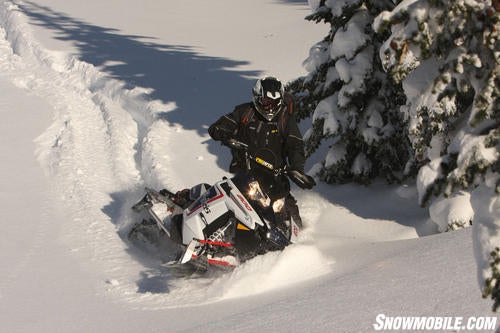 Western Editor Matt Allred rides wrong foot forward on the Pro-RMK 800.
Western Editor Matt Allred rides wrong foot forward on the Pro-RMK 800.He says, “I also count my early years on an Exciter and SRV.” His current ride is a modified 2003 Polaris RMK Edge 800 with a 151-inch track. He continues, “I’ve owned five different snowmobiles.” For riding he says, “I prefer back country riding – off-trail powder riding and boondocking. I enjoy high marking, as long as avalanche conditions aren’t high.”
We added his opinions with ours as he is just one of us, a rider with altitude sickness. We conducted our backcountry test in the mountain range behind Alpine, Wyo. on Jan. 28.
The Stats
We do not claim all data presented here is variable free. Some is solid, such as weight and degree angle to tip over, while others – the speed runs – are for that day, in that day’s conditions for that elevation. Yet from these, we learn how well a sled handles ascents, under load, in rutty conditions. Our hill cross segment tells us about suspension response and handling.
We weigh the mountain sleds and report ready-to-ride (RTR) weights; all fluid levels at max. With a calibrated scale, we lift and let the numbers speak. We begin with the RTR weights.
| Ready-To-Ride Weights | |||
| Polaris Pro RMK 800 | Polaris Pro RMK 600 | Arctic Cat M8 Sno Pro | Ski-Doo Summit X 800 |
| 530 lbs | 526 lbs | 559 lbs | 560 lbs |
| Difference From 2011 Model | |||
| No Change | New Model | +6 lbs | +6 lbs |
| Analysis: Polaris’ RMK Pros remain the lightweight kings. Power-to-weight is champion in the mountains. | |||
| Tipover Angle in Degrees | |||
| Polaris Pro RMK 800 | Polaris Pro RMK 600 | Arctic Cat M8 Sno Pro | Ski-Doo Summit X 800 |
| R-47, L-46 | R-47, L-45 | R-49, L-49 | R-47, L-46 |
| Analysis: A smaller number means easier to roll into a hillside. | |||
| Turning Radius | |||
| Polaris Pro RMK 800 | Polaris Pro RMK 600 | Arctic Cat M8 Sno Pro | Ski-Doo Summit X 800 |
| 22’ 8” | 22’ 9” | 25’ 9” | 22’ 6” |
| Analysis: The two RMKs are one-tenth of an inch apart, yet the S-36 equipped Summit X carved the tightest circle. This points to sound ski pressure, excellent ski rotation and skis that tip – roll into the turn. The M8 cut the widest circle. | |||
| Hill Cross Time (in seconds) | |||
| Polaris Pro RMK 800 | Polaris Pro RMK 600 | Arctic Cat M8 Sno Pro | Ski-Doo Summit X 800 |
| Kevin: 28.76 | Kevin: 30.32 | Kevin: 31.70 | Kevin: 29.30 |
| Kevin: 28.38 | Kevin: 28.21 | Kevin: 30.97 | Kevin: 29.02 |
| Kevin Avg: 28.57 | Kevin Avg: 29.26 | Kevin Avg: 31.33 | Kevin Avg: 29.16 |
| Kade: 29.01 | Kade: 31.86 | Kade: 26.09 | Kade: 27.20 |
| Kade: 26.74 | Kade: 28.87 | Kade: 28.89 | Kade: 27.42 |
| Kade Avg: 27.87 | Kade Avg: 30.36 | Kade Avg: 27.49 | Kade Avg: 27.31 |
| Total Avg: 28.22 | Total Avg: 29.81 | Total Avg: 29.41 | Total Avg: 28.23 |
| Analysis: Using timing lights, the Polaris 800 RMK Pro and Summit 800 X were separated by a meager 1/100ths of a second. The M8 was approximately 1.20 seconds slower. Look at the 600 RMK, it was only 1.59 seconds slower than the quickest time busted out by the 800 RMK. The three 8s and the lone 6 are close in performance in the short chutes. | |||
| 500-Foot Deep Powder Straight Line Time (in Seconds) | |||
| Polaris Pro RMK 800 | Polaris Pro RMK 600 | Arctic Cat M8 Sno Pro | Ski-Doo Summit X 800 |
| 11.98 | 12.75 | 12.37 | 12.38 |
| Analysis: Klinger zipped exceptionally straight lines in the ultra-deep untracked snow. Results show the RMK 800 pulled the quickest time, as it did in the hill cross. The M8 and Summit were 1/100th of second apart. The RMK 600 was 0.77 slower than the quickest time and only approximately 0.37 behind the M8 and Summit. The 600 RMK is not shy. | |||
On The Witness Stand
Arctic Cat M8 Sno Pro MSRP – $12,099 Specs
Matt – The Suzuki-built twin efficiently dumps power to the track; it feels crisper than the direct-drive system from 2011. The M8 performs well in deep snow, but in light and very deep non-structured snow, the Powerclaw track struggles – the M8 trenches, unlike its predecessor, the 2011.
The M8’s narrow and blunt nose balls up snow (when conditions are set so) and halts momentum. If the M8 comes upon a wall – a snow bank or trench cut by another snowmobile – the nose hits the snow barrier and often stops.
The skis turn greater than the handlebars. When cranking the bars right or left, the bars hit their respective stop before full rotation, this causes frustration when initiating sidehill attacks or wrong foot forward downhill-to-uphill turns. Simply, the M’s steering ratio seemed out of sync.
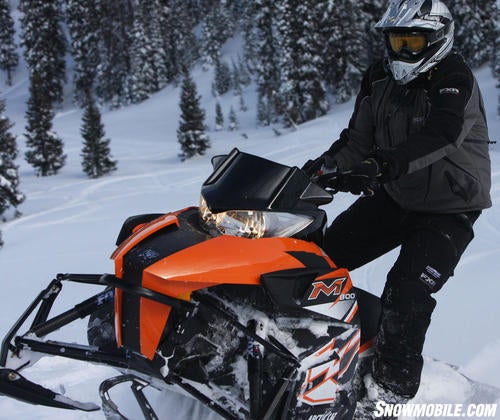 Test rider Kade Klingler pilots the Arctic Cat M8 through the finish line of our hill cross course.
Test rider Kade Klingler pilots the Arctic Cat M8 through the finish line of our hill cross course.The M8’s skis are narrow and appeared to lack significant keel for powder use. The narrow ski does not hold up the M8’s nose; a ProCross ski is not meant to be a ProClimb ski.
The new M8 works quite well, in spite of its freshman year growing pains. When hauling up a steep-n-deep trenched up ravine, the M8 is the most confident of our 800s, and I am learning it is more nimble than its predecessor.
Jake – The ProClimb M8 is impressive. Like the 2011 M8, the ProClimb has great power, it hits hard on the bottom and slams all the way through. We were happy to see the horizontal steering remained on the M8. It is however, not on the standard M8. One dealer said he installed horizontal steering on all standard ProClimb M8s he sold. If Cat is wondering what the public wants, I think the answer is obvious. The ProClimb has good handling. However, the learning curve required to ride it is steeper than the RMK’s. The M8 is approximately 30 lbs. heavier than the RMK 800, and is heavier than the 2011 M8. Cat evolved and improved the M8 into the best selling snowmobile in 2010. I am hopeful Cat will continue to evolve the ProClimb into a great sled.
Kevin – The production model came highly refined from the prototypes we rode. The M8 handles very well in the backcountry – it is easy to sidehill and plays in the powder like a mountain sled should. The new front suspension works great on the trail – it gives a confident feel. It also works great in the backcountry. The rear skid is much improved over previous M8s. The overall ergonomics – handlebars, seat, footrest, and rider position feels right – easy to get used to. The 800 H.O. motor is strong through the entire drive system, though I felt an occasional power loss, as if there was a lean spot in the fuel map. I like the tipped up gauges and adjustable handlebars, but miss the large under the seat storage the previous M8s had. All in all Cat hit the target with the 2012 ProClimb M8.
Kade – I jumped from the Summit to the M8 and my first impression was how stable and in-control the M8 felt. Yet, down the trail it was stiff and I felt every bump where I didn’t feel any with the Summit. When I dove off trail and into the powder, the M8 came to life, it banks in the powder with ease. The power was good and once the sled got up on top of the snow, it was playful and responsive, yet it trenched more than the others – taking the longest to get up on the snow. I like the adjustable handlebars and tilt instrument pod. It was nice to be able to experiment with the telescopic handlebars and see how small adjustments made big differences in leverage.
Ski-Doo Summit 800 X MSRP – $12,249 Specs
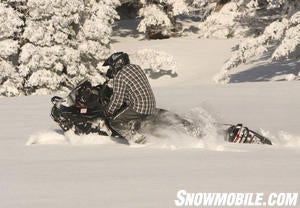 The deeper the powder the more enjoyable the ride on the Summit XP becomes.
The deeper the powder the more enjoyable the ride on the Summit XP becomes.Matt – This S-36-equipped Summit is the best Summit to date – we do admire this sled. This was our sled-of-the year for 2012, and we admire its 800 E-TEC engine, big track, comfy ride and excellent seat. Also, the Summit’s painted tunnel works well at limiting snow to flash freeze on the chassis, weighing the sled down.
In one clear statement, we believe the XP Summit X, so far this season, has the best mountain track of the other brands and models, 16-inches wide with 2.5-inch tall lugs. Its seat and boards are mountain rider specific.
When taking an off-camber plunge into, or off a mountain, the horizontal steering post and its steering wheel-like handlebar rotation sets our arm leverage to a pull-up and push-down fashion, rather than flatly pulling the snowmobile into a hillside. This makes dicey attacks.
We must be truthful – we demand much from BRP. The XP Summit X is a phenomenal mountain sled, no doubt. We can’t find anything wrong with this super sled other than handlebar swing; we implore Ski-Doo to install a vertical steering post into this very remarkable chassis.
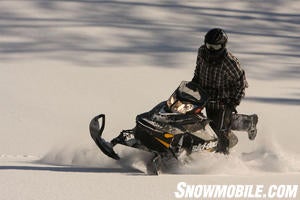 The powder track on this Summit flat out works. The deeper the powder the better.
The powder track on this Summit flat out works. The deeper the powder the better.Jake – The Summit’s power surprised me, it is sneaky fast. Though it doesn’t hit hard on the bottom end, it pulls hard through its powerband and doesn’t let up. The Summit’s track floats the sled up on top of the snow and it stays there; the deeper the snow the better the Summit works. The S-36 package works well as I can sidehill it better than the non-S-36 Summits of yesteryear. Yet, in shallow snow it is difficult to hold a sidehill. When in deep snow and I cut across another track, it does not maintain its stability. Overall, I am impressed with the Summit, yet I would like to see sidehilling issues addressed.
Kevin – Since the introduction of the Summit XP in 2008, in terms of continual improvement, BRP has never rested. Each year there are significant changes to the XP Summit. Model-year 2012 was no exception. Improvements include new seat (with rear storage), redesigned handlebars, new 2.5 inch Powder Max track, and calibration improvements to the 800 E-Tec and S-36 suspension.
The deep snow was slow in coming this year, but when it came it was abundant – we wasted no time getting our powder sleds in the element they were designed for. I learned this is a different Summit from the 2011 in terms of powering through deep snow – the new track, along with the other improvements, is impressive. Last year we referred to the 2011 as the most improved sled. With the 2012 refinements the Summit was reinvented again, and it was our sled of the year; this animal likes deep snow. So far, I’ve been wholly impressed with this new track, strong running 800 E-TEC and amazing suspension. The 2012 Summit X 154 is a favorite.
Kade – The Summit took me awhile to be comfortable with. I found it to be a bit unstable. I was never sure what the front end was going to do, and felt like I would be pitched off at any moment. I smacked the kill switch on three different occasions, which was too easy to hit. When I went to grab the sidehill bar, it wasn’t there; the sidehill bar is mounted with fabric straps and is not solid. I found this to be a big problem as I frequently use the sidehill bar. The steering took a while to get used to. I found the steering to be good down the trail, but tougher to sidehill and boondock than the other models. I was impressed with its smooth trail ride; it ate up the bumps and handled well through the corners. The power was good and the sled pulled hard.
Polaris Pro-RMK 600 and 800 MSRP Pro-RMK 600 – $10,499, Pro-RMK 800 – $11,799 Specs Pro-RMK 600, Specs Pro-RMK 800
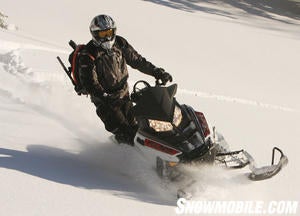 Test rider Kevin Allred shows off the easy side hilling characteristics of the Pro-RMK 600.
Test rider Kevin Allred shows off the easy side hilling characteristics of the Pro-RMK 600.Matt – For 95 percent of mountain riders, the Pro 600 is all we need. This 600 is smart-phone smart; it makes excellent calls when dialing up nasty mountain.
The two Pros are a delight. For the 600 155, when navigating uphill tree infested steep-n-deep climbs, all a driver needs to do is run the six-oh-oh wide open and grin. An 800 driver needs to roll in and out of the throttle to navigate obstacles. Not so with the 600 – wide open all the time. Everywhere our 800s went, there too went Pro 600. The 600 is wholly the same as the 800 Pro 155 – nothing skimpy. The Pro 6 is meant to be as adept to the mountains as its bigger 800 sibling, and it is.
For the Pro 800, in its second year, there are no surprises here. As Kevin said to me one day as he tapped the 800 Pro’s handlebar, “This is my red Dixie cup, I love to fill her up.”
The two Pros climb and sashay up hill and dell with minimal driver input. The vertical-like steering post with Pro Taper handlebars allows us to set up and tackle mountains with ease. The Series 5.1 track proves to be a purposeful all-around track.
With its flat side panels that do not extend beyond the width of its runningboards, the Pro 8 and 6 kept their tracks properly stuffed into a mountainside. These sleds are flickable, which is a must for mountain riding. Because of the Pros’ lightweight and durable chassis, they own approximately 50-percent of all mountain sales for MY2012.
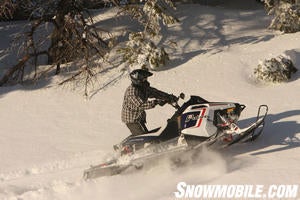 The Polaris shows that it truly is the Rocky Mountain King pulling a side hill during a free ride session on our evaluation.
The Polaris shows that it truly is the Rocky Mountain King pulling a side hill during a free ride session on our evaluation.Jake – For the 600 Pro, all I can say is “Wow!” There is nothing I love better that to zip around on the 600 and have people say how impressed they are with the 800. They are shocked to see it is a 600. The 600 has all of the same great features incorporated into as the 800cc except for the power-to-weight ratio. Polaris has done a fine job with this sled. The Pro 800 is the lightweight king. According to our tests it is 30 lbs lighter than either the Cat or the Ski-Doo. That makes a huge difference in trying to stay on top of the snow. The Pros seems to have little to no learning curve. Just hop on it and ride. The Pro did not gain any weight from its introduction last year. This tells me Polaris did it right the first time. The Pro RMKs have been widely popular, just look at their sales numbers. In my opinion the Pro RMK is the best mountain sled on the market this year.
Kevin – I was eager to weigh the 2012 800 Pro RMK to see if it gained weight from 2011; I nodded my head in approval when I saw the same number on the scale. This tells how successful the Pro’s launch was in 2011, and Polaris found no strengthening was needed for this lightweight chassis. After nearly two seasons of pounding on the Pros, we find no flaws. The 800 Pro gets on top of the snow and holds its line.
The narrow plastic in the area of the bulkhead allows this sled to sidehill and carve in a class all its own; the motor runs strong, suspension works great. At nearly 30lbs lighter RTR weight than its competition…well I’ll let that speak for itself. The 800 Pro is a backcountry mountain rider’s dream. For me this sled just works.
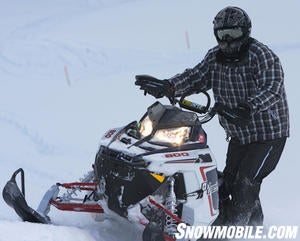 On our hill cross course the Polaris 800 consistently put out fast times.
On our hill cross course the Polaris 800 consistently put out fast times.For the 600 Pro RMK, the same is said of it as the 800, but with a smaller motor. When I think of my experience on the 600 Pro 155, the term comes to mind: no compromise. Meaning, none of us has had to compromise riding an 800, whatsoever, to help the 600. The truth is, if you are on an 800, you better not weaken or the 600 will be in your face letting you know it is there to play. I enjoy my time on the 600 and my ego is satisfied. Look at the above stats, it’s not hard to realize there is not much difference – I am impressed.
Kade – I really liked the feel of the Pro 600 is sled. The power was close to the 800s, more than I expected. It felt smooth, light, and fun. It felt like I could really throw this sled around in the powder without getting off balance. It really got up on the snow quickly and had nice throttle response. I wasn’t a huge fan of the seat. I deal with lower back pain, and the Polaris seat seemed to bring the pain out within a few minutes of riding. It feels like it’s designed to encourage riders to stand up, but I like a comfortable seat when I’m forced to ride the trails getting to and from the back country. I liked the adjustable handlebars and gauges on the Arctic Cat and think it would be a great addition to the Polaris.
For the Pro-RMK 800, basically the same feelings I had while riding the 600. This was my favorite sled to ride. This sled was the easiest 800 to get comfortable with, but that’s probably because I’ve ridden a Pro chassis before. This sled really gets on the snow and takes off. The Polaris feels lights and nimble, but very stable at the same time. The power was great and smooth. This sled holds a sidehill with ease and I found myself overriding it a little. I loved being able to be pointing downhill, slow to a stop, and turn the sled back uphill on a dime. The Polaris rides and handles nice down the trail. I would rate it below the Ski-Doo and above the Arctic Cat in that category. Again I’m not a fan of the seat and would like to see adjustable handlebars and gauges.
Related Reading 2012 Mountain Sled Evaluations: Part 1 2013 Polaris 800 Pro-RMK 155 Preview 2012 Polaris 800 Switchback Pro-R Review [Video] 2012 Polaris 600 Pro-RMK 155 Review [Video] 2012 Ski-Doo Summit 800 Review [Video] 2012 Arctic Cat ProClimb M800 Review [Video] The Best 2011 Snowmobiles for the West 2011 Mountain Sled Evaluation: Part One 2011 Mountain Sled Evaluation: Part Two



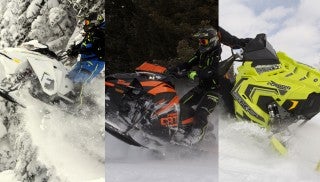
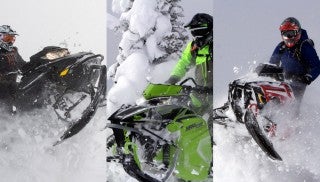
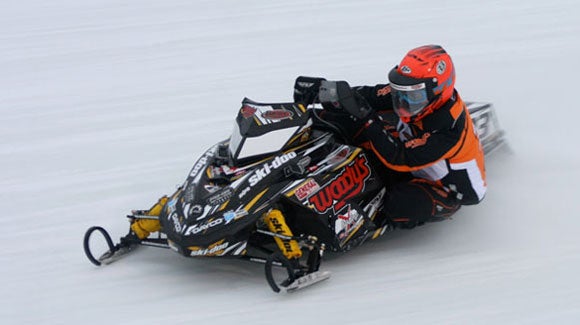


 Your Privacy Choices
Your Privacy Choices